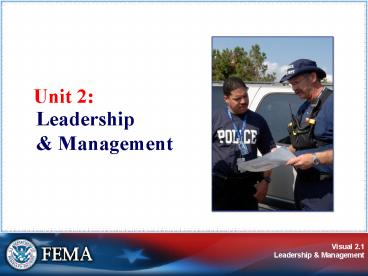Leadership - PowerPoint PPT Presentation
1 / 41
Title: Leadership
1
Unit 2
- Leadership Management
2
Unit Objectives
- Describe chain of command and formal
communication relationships. - Identify common leadership responsibilities.
- Describe span of control and modular development.
- Describe the use of position titles.
3
Chain of Command
4
Unity of Command
- Under unity of command, personnel
- Report to only one supervisor.
- Receive work assignments only from their
supervisors.
- Dont confuse unity of command with Unified
Command!
5
Unity vs. Unified
- What is the difference between unity of command
and Unified Command?
6
Unified Command
- The Unified Command organization consists of the
Incident Commanders from the various
jurisdictions or organizations operating together
to form a single command structure.
7
Unified Command Features
- A single integrated incident organization
- Collocated (shared) facilities
- One set of incident objectives, single planning
process, and Incident Action Plan - Integrated General Staff Only one Operations
Section - Coordinated process for resource ordering
8
Unified Command Benefits
- A shared understanding of priorities and
restrictions. - A single set of incident objectives.
- Collaborative strategies.
- Improved internal and external information flow.
- Less duplication of efforts.
- Better resource utilization.
9
Activity Unified Command
- Instructions Working with your team . . .
- Read the scenario in your Student Manual.
- Identify the potential incident management
issues. - List the incident management issues on chart
paper. - Choose a spokesperson. Be prepared to present
your findings to the class in 10 minutes.
10
Communications Overview
11
When To Use Formal Communication
- Formal communication must be used when
- Receiving and giving work assignments.
- Requesting support or additional resources.
- Reporting progress of assigned tasks.
12
Informal Communication (1 of 2)
- Is used to exchange incident or event information
only. - Is NOT used for
- Formal requests for additional resources.
- Tasking work assignments.
- Within the ICS organization, critical information
must flow freely!
13
Informal Communication (2 of 2)
- Examples of informal communication are
- The Communications Unit Leader may directly
contact the Resources Unit Leader to determine
the number of persons requiring communications
devices. - The Cost Unit Leader may directly discuss and
share information on alternative strategies with
the Planning Section Chief.
14
Activity Incident Communications
- Instructions Working with your team . . .
- Read the case scenario in your Student Manual.
- Identify strategies to address the communications
problem. - List the strategies on chart paper.
- Choose a spokesperson. Be prepared to present
your findings to the class in 10 minutes.
15
Discussion Question
- Why is leadership an essential element of
successful incident management?
16
Activity Incident Leadership
- Instructions Working with your team . . .
- Identify a highly effective incident leader you
have known or know about. - List the main leadership qualities that such an
individual must possess. - State how these qualities relate to leadership in
incident response. - Choose a spokesperson. Be prepared to present
your findings to the class in 5 minutes.
17
Leadership
- Leadership means . . .
- . . . providing purpose, direction, and
motivation for responders working to accomplish
difficult tasks under dangerous, stressful
circumstances.
18
Common Leadership Responsibilities
- A good operational leader
- Communicates by giving specific instructions and
asking for feedback. - Supervises the scene of action.
- Evaluates the effectiveness of the plan.
- Understands and accepts the need to modify plans
or instructions. - Ensures safe work practices.
- Takes command of assigned resources.
- Motivates with a can do safely attitude.
- Demonstrates initiative by taking action.
19
Leadership Duty
- Leaders should
- Know, understand, and practice the leadership
principles. - Recognize the relationship between these
principles and the leadership values. - Commit to excellence in all aspects of their
professional responsibility.
20
Commitment Duty
- Take charge within your scope of authority.
- Be prepared to assume a leadership role.
- Be proficient in your job.
- Make sound and timely decisions.
- Ensure tasks are understood.
- Develop your subordinates for the future.
21
Discussion Question
- What can you do to demonstrate your commitment to
duty to those you lead?
22
Leadership Respect
- Know your subordinates and look out for their
well-being. - Keep your subordinates and supervisor informed.
- Build the team.
23
Activity Building Damaging Respect
- Instructions Working individually . . .
- List leadership actions that can damage and build
respect. - Record your answers as follows
- Be prepared to present your findings to the class
in 5 minutes.
24
Leadership Integrity
- Know yourself and seek improvement.
- Seek responsibility and accept responsibility for
your actions.
What acts of integrity have you witnessed at an
incident response?
25
Communication Responsibilities
- To ensure sharing of critical information,
responders must - Brief others as needed.
- Debrief their actions.
- Communicate hazards to others.
- Acknowledge messages.
- Ask if they dont know.
26
Briefing Elements
- Provide complete briefings that include clearly
stated objectives and the following elements
27
Incident Management Assessment
- Assessment methods include
- Corrective action report/ after-action review.
- Post-incident analysis.
- Debriefing.
- Post-incident critique.
- Mitigation plans.
28
Discussion Question
- What questions would you use to assess the
effectiveness of incident management?
29
Using Common Terminology
- Once the incident is formally designated, ICS
terminology is always used for - Organizational functions.
- Incident facilities.
- Resource descriptions.
- Position titles.
30
ICS Organization Review (1 of 2)
31
ICS Organization Review (2 of 2)
Whos responsible for what?
32
ICS Management Span of Control
- ICS span of control for any supervisor
- Is between 3 and 7 subordinates.
- Optimally does not exceed 5 subordinates.
33
What Influences Span of Control?
- Span of control is influenced by
- The type and complexity of incident or event.
- The nature of the response or task, distance, and
safety.
34
Modular Organization
- Teams, Divisions, Groups, Branches, or Sections
are - Organized when the supervisory ratio exceeds 7.
- Demobilized when the supervisory ratio falls
below 3.
35
Typical Organizational Structure
- In approximately 95 of incidents, the
organizational structure consists of - Command
- Single Resources
36
Expanding Incidents
- Incidents that begin with single resources may
rapidly expand requiring significant additional
resources and support. - Expanding incidents may add supervisory layers to
the organizational structure.
37
Use of Position Titles
- Using specific ICS position titles ensures
- A common standard for performance expectations.
- That qualified individuals fill positions.
- That required personnel are qualified.
- Standardized communication.
- Awareness of the responsibilities involved with
the position.
38
ICS Supervisory Position Titles
39
Activity The Expanding Incident
- Instructions Working with your team . . .
- Review the scenario in your Student Manual.
- Identify the supervisory structures (Divisions,
Branches, Groups, Strike Teams, or Task Forces)
that you would use to ensure a proper span of
control for the resources currently on the scene. - For each organizational element, indicate the
title of its supervisor. - Choose a spokesperson. Be prepared to present
your answers to the class in 15 minutes.
40
Summary
- Are you now able to
- Describe chain of command and formal
communication relationships? - Identify common leadership responsibilities?
- Describe span of control and modular development?
- Describe the use of position titles?
41
(No Transcript)































